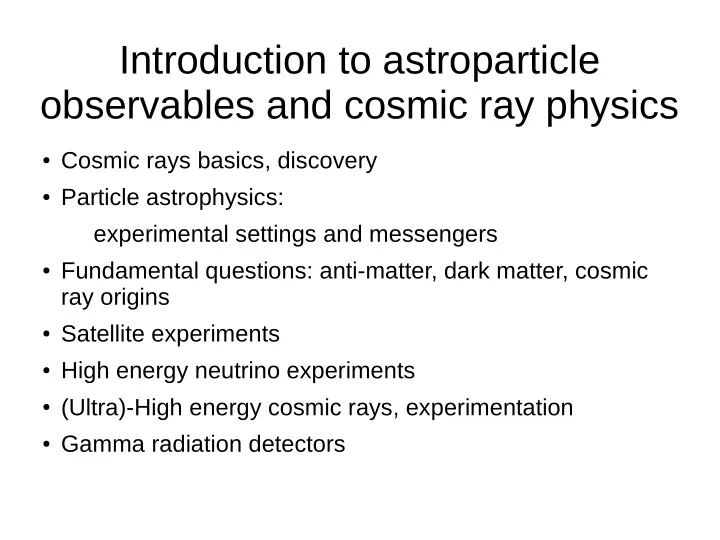

Introduction to astroparticle observables and cosmic ray physics ● Cosmic rays basics, discovery ● Particle astrophysics: experimental settings and messengers ● Fundamental questions: anti-matter, dark matter, cosmic ray origins ● Satellite experiments ● High energy neutrino experiments ● (Ultra)-High energy cosmic rays, experimentation ● Gamma radiation detectors
Experimental settings overview ● Relevance of atmospheric effects
Antimatter: antiprotons ● BESS (balloon), AMS (satellite) ● Matter / antimatter asymmetry, is there antimatter region of the universe ● A single anti-carbon nucleus proves the existence of an anti-matter world
Can anti-protons come from DM (WIMP-s, neutralino?) ● Anti-proton production consistent with CR and interstellar material interaction
Antimatter:Positrons (various sources, shorter lifetime, more effects from solar magnetic field) ● Max/min sunspot, sensitive to DM
AMS (see talk by G. Pásztor) ● Experiment at the ISS ● Full “Particle Physics” toolkit: tracking, PID
BESS: balloon experiment ● Long term flights (months), 38km (1% pressure!)
BESS flight system: cost efficiency ● The balloon is also an engineering marvel
Sources of (high energy) cosmic rays ● Is it uniform? How modified during travel (GZK-like, intergalactic material?) What is the composition? ● Galactic magnetic field: minimal above 10^20eV ● Active Galactic Nuclei (massive BH) ● Magnetars (fast spinning high magnetic field) ● Gamma Ray Burst - correlated
Cosmic rays ● Falling as 1/E^3 ● 25 orders in flux ● Structures Knee, Ankle
Acceleration scheme: “Hillas plot” ● E approximately: Z B R ● Sources up to few EeV
UHECR: the very tail of CR ● Dedicated Extended Air Shower (EAS) detectors
Greisen-Zatsepin-Kuzmin cutoff ● UHECR interaction with CMBR ● Propagation distance 100Mly ● Mechanism: p+gamma → Delta → p+pi0 ● For high energy nuclei, dissociation! So even faster decay ● Length scale (time scale): 100My
EAS: Pierre Auger Observatory
Detection techniques at PAO ● Fluorescence in atmosphere (N2, at clear night) ● Scintillator tanks (high area, all time)
Fluorescence: precision measurement, like calorimetry ● 3D imaging of the shower, lateral and longitudinal profile to be compared to simulations ● Direct comparison to ground arrays
Ground array ● It is large. 1.5km spacing: 5 – 10 towers hit at a time ● Arrival time comparision gives angular information (typical 1 degree at 10EeV)
Air shower, complicated development ● Electrons and muons (10 EeV proton) (Sergio Sciutto for AIRES, UChicago)
Typical event with both observation techniques ● Energy and direction ● Precision comparison of the two measurements ● Shower profile (nearly reaching surface)
Neutrinos: a truly penetrating messenger (See also talk of Emma Kun) ● (25 orders of magnitude in relevant energy) ● High and very high E neutrinos: special “particle physics” detectors. Note: xsect goes with E ! ● One of the most relevant sources: p + gamma → pi+ + neutron → neutrino ● On Earth: also Atmospheric ● Example cosmic neutrino detector: ICECUBE
Neutrino sources ● Low energy: solar; Medium energy: Atmospheric; High energy: interaction with UHECR (J. Becker)
IceCube Detector at Antarctica ● A truly big array of down-looking photo- multipliers
Upward-going neutrinos! ● Interaction in Earth crust with high xsection! few 1000km interaction length ● Ensuring appearance inside detector volume
Gamma rays: very special direct sources (see talk by Zsolt Bagoly) ● Active Galactic Nuclei ● Neutron stars and (ms) pulsars ● Gamma Ray Bursts (short time)
Gamma rays: FERMI satellite ● Soruces: decays, cosmic ray interactions ● One most relevant source: p + gamma → pi0 + proton → gamma; also inverse Compton
Fermi LAT instrument: tracking combined with calorimetry ● Very good angular (direction) resolution (first e+e- pair) ● Extremely low background, rejection of charged and out-of- sight gamma signals
Conclusions ● Particle-astrophysics: very interesting and scientifically decisive astro-messengers to be studied ● Astro-particlephysics: high energy instrumentation in astro-settings ● Multi-messengers with very different observables and detector systems ● Large collaborations (satellite, UHECR, gamma, neutrinos)
Sources ● Open promotional online materials ● Large collaboration press releases and public images ● ICRC proceedings ● Credited sources: Anni Adams,
Recommend
More recommend